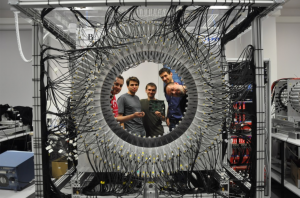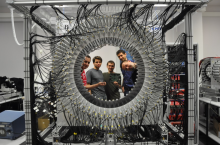For the first time in the world, the creators of the Krakow-based J-PET showed how to obtain additional valuable information about the location of lesions. The method is based on the analysis of processes involving positronia arising in the patient’s body. The first very promising images have already been obtained, and the results have been published, among others in the journal Nature Communications. Scientists from NCBJ are the co-authors of the new method.
PET, or Positron Emission Tomography, is a method of imaging the patient’s anatomy based on the recorded radiation (photons) emitted from the inside of the human body. In order to perform the test, the patient is administered a radiopharmaceutical containing a radioactive element – a radioisotope, which emits an electron antiparticle, i. e. positrons, during the decay. The most commonly used radioisotope is fluorine 18. Positrons, as antimatter particles, when they combine with electrons (particles of matter), emit two collinear photons (moving along one straight line, facing in opposite directions). This process is called annihilation. The radiopharmaceutical is concentrated mainly in the most energy-consuming cells, such as cancer cells. The emitted photons are registered in the scanner, which allows to determine the position of the source of their emission. The whole process is about recording the place, energy and times at which the pair of photons was observed. However, to obtain a three-dimensional image, there is still a long way to the work of algorithms, without which the image of the patient’s body and cancer cells at the end of it would not be possible.
Scientists from the Jagiellonian University in cooperation with, among others, researchers from the National Centre for Nuclear Research are working on a new generation of positron emission tomography devices – Jagiellonian PET. The photon detectors used in PET tomography use the scintillation phenomenon. Scintillators consist of atoms which absorb some of the energy of the incident photon, and convert it into photons in the visible light range, which are then registered by the scanner electronics. This means that instead of one high-energy photon, we register many photons with less energy. Jagiellonian PET differs from classic PET machines in the technology of detectors. Instead of the more expensive inorganic scintillation crystals (not containing carbon atoms), commonly used in PET technology, it uses organic (carbon-containing) plastic scintillators. The use of plastic detectors significantly reduces the production costs of such equipment, but this is only one of the advantages of the innovative solution. It turns out that the unique properties of the scanner allow it to go beyond conventional PET imaging methods and create a completely new, complementary imaging method using quantum effects related to the formation and annihilation of positronium.
A positronium is a short-term system (bound state) of an electron and a positron, similar to a hydrogen atom, in which, instead of a proton, there is a positron (electron antiparticle, i. e. a particle with a positive charge). After a short time, such a system annihilates directly or with the participation of an electron from the environment. Throughout the process, it is possible to observe four photons (under vacuum conditions), including three related to the annihilation process. On the other hand, in a material medium, such as a human organism, three photons can most often be registered: two from positronium annihilation, each with an energy of 511 keV, as in classic PET, and an additional photon with an energy of 1274 keV, derived from the deexcitation of the radiopharmaceutical atom. It allows to determine the moment of positronium formation. J-PET detectors record all three photons with the appropriate energies. And while distinguishing the starting photon from the other two is simple (it has a much higher energy), pairing annihilation photons from the same annihilation is more difficult. The de-excitation photon gives us the starting point for the measurement of time. We consider two annihilation photons as coming from the same annihilation if the time of their registration in two opposite detectors is close enough – on the order of 3 ns (1 nanosecond is one billionth of a second). The time between the registration of both photons from the annihilation gives us information about the position (if the emission source is closer to any detector, it will first register it, then the corresponding detector on the other side). Knowing the time and speed of the photons, we calculate the distance of the emission source from the detectors. This gives us a three-dimensional picture of the photon emission, however, we do not yet know which of these emissions come from diseased sites. Depending on the environment in which the decay occurs (cancer cells create different conditions than healthy cells), the lifetime of the positronium, i. e. the time between the emission of the initial photon and annihilation, varies. As a result, it is possible to distinguish a lot of sick cells from healthy ones with even greater precision than in classic PET. All this complicated process of timing from each detector has to be done on the fly so that the examiner can get a useful picture quickly and not after many hours of calculations. This is where appropriate computer algorithms come in handy, which build information that is ready to use from the chaotic sequence of time counts.
At Total-Body Jagiellonian-PET Laboratory, the first positronium-based image was captured using the prototype J-PET scanner, and a group of NCBJ scientists participating in the Jagiellonian-PET project is developing algorithms for image reconstruction. „The data analysis software used to obtain the current results was created as a result of many years of joint effort by a group of people, whose members include people from both the Jagiellonian University and the NCBJ” – says Dr Eng. Wojciech Krzemień from the NCBJ Department of High Energy Physics. „I had the pleasure to coordinate this work. The participation of the National Centre for Nuclear Research consists in developing algorithms for image reconstruction, procedures and programming tools for data analysis, thanks to which we can process this data. And this is a very large contribution, without which these analyzes would not be possible at all. Our additional contribution to the work on J-PET is the use of machine learning methods to analyze tomographic data. "
The new PET imaging method is not only cheaper than those used in PET devices currently available on the market, but also more precise. The first pictures in this technique were taken on a 50 cm phantom composed of heart myxoma tissue and adipose tissue. The authors of the research expect that their method will allow for the imaging of larger volumes, up to 200 cm long, which will make it possible to take pictures of the entire body at one time, while the commonly used PET devices are able to take pictures of about 20 cm of a part of the body. PET tomography is used not only in cancer diagnostics, but also for imaging in other diseases, such as heart diseases. Scanning the whole body with the J-PET device will help in the diagnosis of diseases that cause changes in the entire body, from the earliest stages of their formation at the cellular level. The creators believe that the device can also be used to diagnose complications after Covid-19.
The authors have already published the results of their research in reputable scientific journals, such as a recent work in Nature Communications, where they used J-PET in basic research, or a work in Science Advances, where the idea of using the scanner for medical purposes was described. Intensive work is underway to develop the device and the new method.
Sources:
https://www.science.org/doi/10.1126/sciadv.abh4394
https://www.nature.com/articles/s41467-021-25905-9
https://www.physicamedica.com/article/S1120-1797(20)30254-4/fulltext
https://www.sciencedirect.com/science/article/pii/S1361841521002449?via%3Dihub
Additional information
Jagiellonian PET (J-PET) is the first positron emission tomography scanner built of plastic scintillators. The Jagiellonian PET Consortium led by P. Moskal is an interdisciplinary and international group consisting of physicists, chemists, electronics, computer scientists, quantum information physicists and bio and medical physicists from the Jagiellonian University, National Center for Nuclear Research, Maria Curie-Skłodowska, University of Vienna, National Laboratory in Frascati, as well as Nowoczesna Elektronika and Brain Waves Electronics. More on the project website: http://koza.if.uj.edu.pl/pet/







